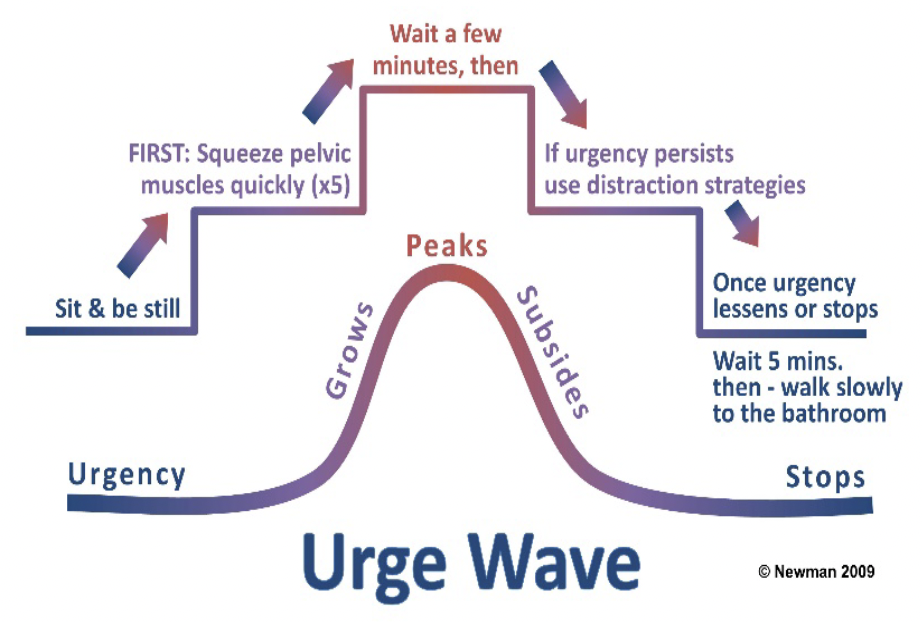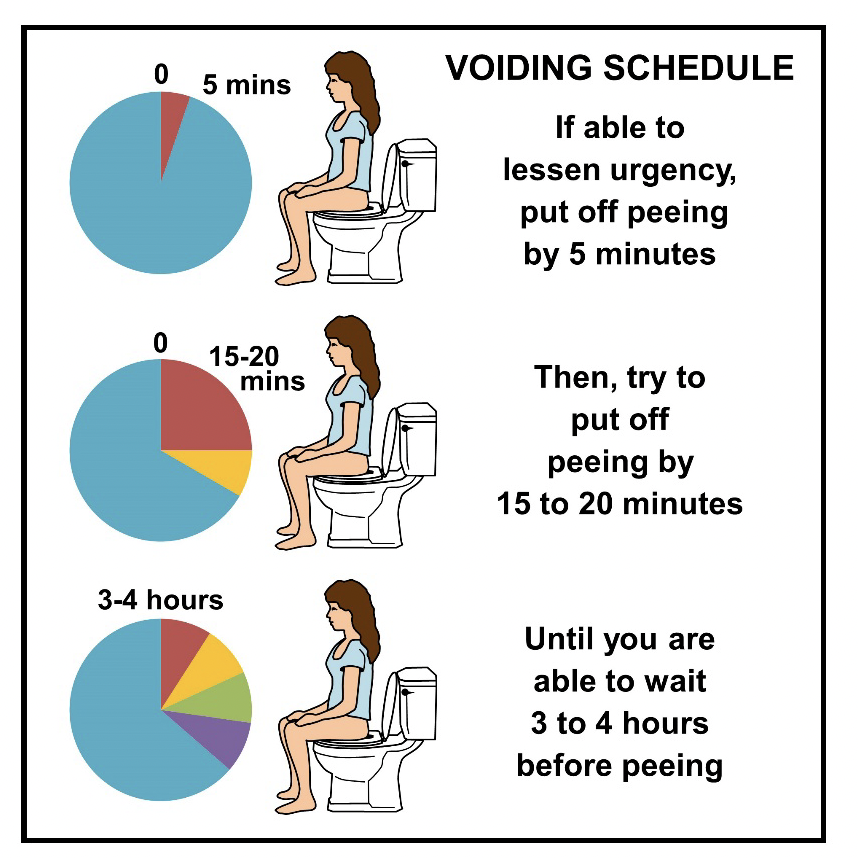URGENCY is a signal from you brain telling you your bladder wants to be emptied right away. It feels like a strong need to pee that comes on suddenly, usually not expected. It can cause you to go pee more often. And urgency can lead to bladder leaks on the way to the bathroom. Most times, the amount of urine leaked (urinary incontinence) is only small but it can be a lot, all the urine in your bladder. Common things that bring on urgency are: hearing running water, putting your key in the door at home, when washing dishes or clothes or seeing a sign for a toilet.
FREQUENCY is peeing often, usually 8 times or more in a day. Bladder frequency can get worse if you start the habit of peeing “just in case.” With frequency, the bladder never fills completely and gets used to holding only a small amount of urine, giving you the “urge to pee” sooner and sooner.
URGENCY BLADDER LEAKS happen when the bladder muscle starts to contract before you get to the toilet. Like in the picture below, urgency follows a wave pattern; it starts, grows, peaks, and then subsides until it stops. The key to controlling bladder urgency is by practicing “bladder training” that uses methods like “urge suppression” which are calming messages to your brain to stop you peeing so often. So, when you feel a sudden, urgent need to pee, do not rush or run to the bathroom. Rushing will jiggle your bladder and increase the feeling of urgency and may cause bladder leaks.

Ways to Take Control of Urgency
You can take control over your bladder urgency in these simple ways:
• Focus on another body sensation. Deep breathing is good. Sit down and take five slow, deep breaths. Think about the air moving in and out of your lungs instead of how your bladder feels.
• Squeeze your pelvic muscles. So when urgency comes on, sit and do a couple of gentle pelvic muscle squeezes, just 3 to 5 squeezes. This will calm your bladder and the urgency will go away. You can also try holding one strong squeeze of your pelvic muscles. Try each way and see which one works best for you.
• Distract yourself. If you get you mind off your bladder long enough, the feeling of urgency will often pass. One way is by focusing on a mental activity like a mind game. Another way is to turn your attention to counting backward from 100 by 7s or working on a crossword puzzle.
• Do a task that requires a lot of thought—for example, play a game on your computer or iPad or phone, write a letter, plan the weekly food menus, or some other activity that focuses your thinking. Note: TV watching and talking on the telephone are not distracting enough.
• Use self-talk or good self-statements. Tell yourself: “I am the boss, not my bladder.” “I am in control.” “I can beat this.” Find a statement that fits your situation and personality the best. Keep saying this statement over and over until the feeling of urgency passes.
Sometimes you will need to perform more than one of these methods before the feeling of urgency goes away. If at first you do not succeed, do not give up. Remember, it takes practice to gain control over bladder urgency. But over time, you will gain more control and have fewer feelings of urgency.
When to Go to the Toilet to Pee
After the urge goes away, try to put off peeing by waiting a few minutes- maybe 5 minutes. Lessen urgency and calm down your bladder by following some of the control suggestions. If you don’t think you can wait that long, then go to the toilet whether you feel you have to go or not.
Once you can easily wait 5 minutes before peeing, stretch the time by waiting 10 to 15 minutes. The goal is for you to increase the time between peeing.
Never rush or run to the bathroom as fast movement may cause urine leakage. So walk slowly. If the urgency returns on the way to the toilet or in the bathroom, STOP, stand still, and squeeze your pelvic muscles until your bladder calms down.
When to Try Bladder Training
Begin by only practicing this at home where you are relaxed and the bathroom is nearby. Empty your bladder right before going to sleep to lessen the chances of waking up to pee. Don’t forget to cut down on drinks with caffeine and alcohol.
When Will I See a Change?
In 3 to 4 weeks, you should see improvement. You should only be peeing every 3 - 4 hours or even every 5 hours during the day and be up less often at night to pee. Do not despair or get discouraged if you do not see quick results.
©2009/2020 Diane Newman PATIENT EDUCATION – BLADDER TRAINING


